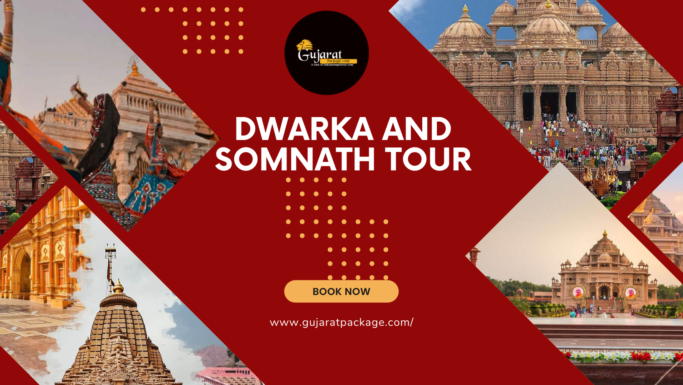Gujarat Tourism : Gujarat is a state of India that lies on the western coast, facing the Arabian Sea. It is known for its rich and diverse culture, its vibrant economy, and its historical significance. But how did Gujarat become what it is today? In this blog post, we will take you on a journey through time, exploring the ancient and medieval history of Gujarat Tourism, and how it shaped its present and future.
The earliest evidence of human settlement in Gujarat dates back to the Stone Age, when people lived in caves and used tools made of stone. Later, during the Chalcolithic and Bronze Age periods, Gujarat witnessed the rise of the Indus Valley Civilisation, one of the oldest and most advanced urban cultures in the world. The Indus Valley people built cities, traded with other regions, and developed a sophisticated script and religion. Some of the major sites of this civilisation in Gujarat are Lothal, Dholavira, Rangpur, and Surkotada.
The Indus Valley Civilisation declined around 1500 BCE, and was followed by the Vedic Civilisation, which was based on the Indo-Aryan culture and religion. TDuring this time, the Vedas, the oldest Hindu scriptures, were written. Gujarat was divided into several kingdoms and tribes, such as the Abhira, Anarta, Dwaraka, Sindhu, and Saurashtra. These kingdoms were often involved in wars and alliances with each other and with other powers in northern India.
Around 600 BCE, Gujarat became part of the Nanda Empire, which was succeeded by the Maurya Empire in 321 BCE. The Mauryan emperor Ashoka (c. 250 BCE) left his edicts on a rock in Girnar Hills, proclaiming his policy of dharma (righteousness) and non-violence. After the collapse of the Mauryan Empire, Gujarat came under the influence of various dynasties, such as the Indo-Scythians, the Western Satraps, the Kushans, the Vakatakas, the Guptas, and the Maitrakas. These dynasties contributed to the development of trade, art, literature, and religion in Gujarat.
In the 8th century CE, Gujarat was ruled by the Gurjara-Pratihara dynasty, from which it derives its name. The Gurjaras were a clan of nomadic warriors who migrated from Central Asia and established their kingdom in northern India. They were known for their resistance to the Arab invasions from Sindh. Gujarat also witnessed the rise of local dynasties, such as the Chavdas, the Chudasamas, and the Chaulukyas (also known as Solankis), who built temples, forts, and cities across the region.
The Chaulukya dynasty reached its zenith under Siddharaja Jayasimha (c. 1094–1143 CE) and Kumarapala (c. 1143–1174 CE), who expanded their territory and patronised Jainism. However, their power declined after they were defeated by the Muslim invaders from Delhi in 1299 CE. Gujarat then became part of the Delhi Sultanate, which was later replaced by the Gujarat Sultanate in 1407 CE.
The Gujarat Sultanate was an independent Muslim kingdom that ruled over most of Gujarat for nearly two centuries. It was founded by Zafar Khan Muzaffar (later Muzaffar Shah I), a governor of Delhi who rebelled against his overlord. The sultans of Gujarat were known for their naval prowess, their trade relations with foreign countries, and their tolerance towards other religions. They built mosques, mausoleums, palaces, and markets in their capital Ahmedabad (founded by Ahmad Shah I in 1411 CE) and other cities.
The Gujarat Sultanate came to an end in 1573 CE when it was annexed by the Mughal Empire under Akbar. The Mughals ruled over Gujarat for almost two centuries until they were challenged by the Marathas in 1756 CE. The Marathas established their control over most of Gujarat by defeating or allying with various local rulers. They also faced competition from other European powers such as Portugal (which had colonised parts of coastal Gujarat since 1534 CE), Britain (which had established its East India Company in Surat in 1612 CE), France (which had allied with some Maratha chiefs), and Holland (which had set up trading posts in several ports).
In 1819 CE, after a series of wars between Britain and Marathas (known as Anglo-Maratha Wars), Gujarat came under the British Raj. The British divided Gujarat into several princely states, residencies, agencies, and districts under their direct or indirect rule. They also made Bombay (now Mumbai) the capital of the Bombay Presidency, which included most of Gujarat. The British introduced railways, roads, education, law, and administration in Gujarat, but also exploited its resources and people.
The people of Gujarat participated in the Indian independence movement against the British rule, led by Mahatma Gandhi, who was born in Porbandar in 1869 CE. Gandhi established his Sabarmati Ashram in Ahmedabad in 1915 CE, from where he launched many of his campaigns such as the Non-Cooperation Movement, the Salt March, and the Quit India Movement. He was also supported by other freedom fighters from Gujarat, such as Sardar Vallabhbhai Patel, Morarji Desai, and Indulal Yagnik.
After India gained its independence in 1947 CE, Gujarat became part of the Bombay State. However, there was a demand for a separate state for Gujarati-speaking people, which was finally realised in 1960 CE when Bombay State was bifurcated into Maharashtra and Gujarat. The new state of Gujarat had Gandhinagar as its capital (named after Gandhi), and Ahmedabad as its largest city. Since then, Gujarat has witnessed rapid economic growth and social development in various fields such as agriculture, industry, trade, education, health, and tourism.
Gujarat is a land of diversity and dynamism, where the past and the present coexist harmoniously. It is a land of legends and heroes, of saints and sages, of festivals and fairs, of art and architecture, of music and dance, of food and fashion. It is a land that invites you to explore its history and culture, to enjoy its natural beauty and hospitality, to experience its spirit and vitality. It is a land that will make you fall in love with it.
We sincerely hope you have enjoyed travelling through time with us. If you want to know more about Gujarat or plan your trip to this amazing state, please visit our website gujaratpackage.com or contact us at info@gujaratpackage.com. We will be happy to assist you with your travel needs and make your Gujarat Tourism a memorable one.


